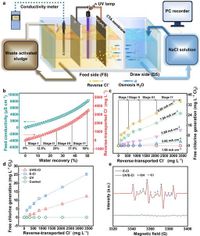In China, the challenge of managing waste activated sludge (WAS)—a byproduct of wastewater treatment—has become increasingly pressing, with approximately 60 million tons produced annually, most of which is water. A novel approach to tackle this issue has emerged from recent research published in Nature Communications, highlighting an innovative forward osmosis (FO) system that employs in-situ ultraviolet/electrooxidation (UV/E-Cl) to enhance sludge conditioning and dewatering.
This cutting-edge technology leverages dynamic reverse chloride ions (Cl−) to effectively mitigate gel fouling, a critical barrier to the efficiency of the FO process. The researchers achieved remarkable water flux rates, attaining an impressive 614% increase over conventional methods, while significantly reducing membrane fouling resistance.
Central to this breakthrough is the targeted attack on the protein and polysaccharide fractions within the extracellular polymeric substances (EPS) that contribute to the gel-like barriers that form on membranes during water filtration. Through a combination of density functional theory (DFT) simulations and interfacial thermodynamics, the study revealed that the interaction between proteins and polysaccharides promotes a structural configuration conducive to fouling. The application of UV/E-Cl was able to decrease the adhesion energy of these foulants by a staggering 97.51% by cleaving cross-links that contribute to their gel structure.
Moreover, the importance of water occurrence states was underscored, with the researchers demonstrating that shifts from bound water to free water around network pores were responsible for alleviating gel fouling. They quantified this effect, attributing 90.71% of filtration resistance to the chemical potential variation associated with water states.
This research not only addresses the pressing challenge of sludge management but also introduces a novel resolution to the complex problem of membrane fouling, which has limited the effectiveness of FO systems in wastewater treatment. The findings imply a significant step forward in developing more resource-efficient methodologies for managing sludge, thus alleviating environmental concerns surrounding its disposal.
The FO process, compared to traditional dewatering methods, offers lower energy consumption and provides better effluent quality. This state-of-the-art UV/E-Cl process could be utilized broadly, beyond just WAS, potentially extending to various types of organic sludge with high water content.
Further experiments demonstrated the effectiveness of this method under varying conditions—a notable feature as it revealed that the reverse Cl− concentration could support free chlorine generation necessary for optimal FO efficiency. The study recorded an exceptional performance increase with average water fluxes significantly higher than those in standard E-Cl methods, securing the integrity of membranes throughout numerous cycles.
However, the research does not stop at improving sludge management; it has implications for a wide range of wastewater treatment processes. Future investigations may focus on optimizing reactor conditions and exploring the use of other oxidants alongside UV/E-Cl, fueling a potential transformation in how industrial wastewater is purified.
In summary, the integration of UV/E-Cl into forward osmosis systems constitutes a promising frontier in the sustainability and efficiency of wastewater treatment, offering much-needed solutions to a burgeoning environmental challenge.

